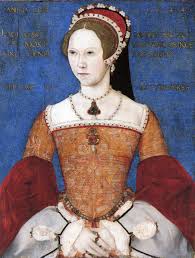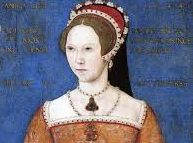
In 1516, Henry VIII and Catherine of Aragon had been married for seven years. Catherine had been pregnant more than seven times, though all her children had been stillborn or died shortly after birth – most notably a son, Henry, who lived for 52 days before sloughing his mortal coil.
Finally, Catherine gave birth at Greenwich to a healthy girl. The delighted parents named her Mary, and christened her “with great ceremony” three days later at the Church of Observant Friars. Her godparents included her great-aunt the Countess of Devon, Lord Chancellor Thomas Wolsey, and the Duchess of Norfolk. Henry was immensely proud of his daughter, doted on her….but became more and more disappointed that no little brother came to join her in the nursery.
In 1516, Catherine was only 31, there was still time for the royal couple to be blessed. Unfortunately, Catherine became pregnant for the last time in 1518, giving birth to a daughter on November 10 who lived only a short time after birth. The couple continued to try for another decade, even after it because increasingly obvious that their efforts would be in vain.
In Catherine’s eyes, Mary was a fine heir to the throne of England. After all, her own mother – the great Isabella of Castille – had been a formidable queen, marrying Ferdinand of Aragon and uniting Spain into a great power. Catherine believed in bloodline, in destiny. If God saw fit to send only a girl, she must be destined for great things.
Unfortunately, Henry disagreed. He believed, and many shared his view, that any prince Mary married would hold the true power – and convert England into little more than a foreign province. This was to be avoided at all costs. In 1519, Henry’s mistress Bessie Blount gave birth to a son, Henry. The King took this as confirmation that the failure lay entirely with Catherine – and showed off his success by giving the boy the surname FitzRoy (“Fitz” = son, “Roy” = of the King). Many believe that Henry had started by 1525 to seek ways to legitimize his bastard son – that was the year he named the healthy six year old Duke of Richmond and Somerset. He might have continued on this path, except that Anne Boleyn appeared on the scene and offered yet another alternative…
* * *
If you like my posts, you’ll love my books! My Seymour Saga trilogy tells the gripping story of the short-lived dynasty that shaped the Tudor Era. Jane the Quene skews romantic, The Path to Somerset is pure Game of Thrones (without the dragons), and The Boy King is a noir coming-of-age. Get them now through Amazon, Barnes & Noble, Kobo, and Apple, or even your local independent bookstore!

(PS Already read them? Did you love them? Then please review them – even just a stars rating! It makes a huge difference in helping new readers find them and would mean the world to me!)

Reblogged this on Donmaker's Blog.
Great blog post!